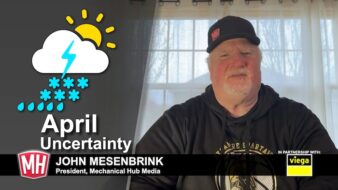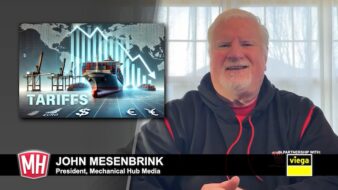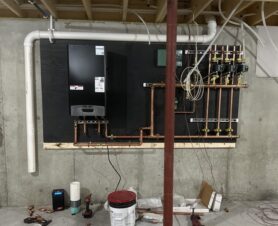A major change to the water heater market is on the way, creating both challenges and opportunities for plumbing, heating and HVAC contractors, designers and engineers.
New energy efficiency mandates from the U.S. Department of Energy (DOE) will take effect on April 16, 2015. They require higher energy factor (EF) ratings on virtually all residential water heating products including gas-fired, oil-fired, electric, tabletop, instantaneous gas-fired and instantaneous electric. Tankless systems already exceed these EF requirements, and all other water heating products manufactured before the DOE mandates take effect can still be bought and installed after the changeover date.
“It’s important for contractors to become familiar with the new rules and the technology options,” said Ralph Perez, director of product management, A.O. Smith, in an interview with Perspective Media. “There are products available that comply with the 2015 regulations, but they are generally not yet in the mass market.”
While all affected models will see an increase in the EF requirement, the most dramatic changes are in larger capacity models (see accompanying chart). That’s because the only technologies that now meet the EF requirements over 55 gallons are electric heat pump water heaters and high-efficiency condensing gas water heaters.
Chad Sanborn, product marketing manager, Bradford White Water Heaters, says contractors should start preparing now so that they are familiar with the water heating options, including the features, benefits and installation requirements of these products. “Employees will need to come up to speed on the new technologies,” he said. “Training on the new products will be critical, and this obviously comes at the sacrifice of revenue generating production from the employee.”
Key issues for designers and contractors
Designers and contractors should be thinking about a number of issues when preparing for the changes in the residential market. For example, achieving a higher EF rating often means adding more insulation to the tank, making it larger and thicker, and more insulation may be required for piping and fittings. Therefore, a larger post April 2015 water heater might not fit into the same space as the current model, posing a challenge when a replacement is necessary.
Condensing gas water heaters are usually significantly heavier than standard models. They may also require flue dampers or electronic ignition. Oil-fired products may also need extra insulation, as well as flue dampers or new combustion systems.
“Many installations that were once a one-person job may now require two people,” Sanborn added. “As water heaters get larger and heavier, they prove to be too awkward to handle by one person. This is especially true when talking about those models over 55 gallons. Service trucks may also need to change to accommodate transporting the taller, wider and heavier equipment.”
Because gas water heaters also have electronic control systems and require 120-volt service, contractors may need to purchase multi-meters for smooth installations as well as trouble-shooting. They may also need to price in the additional time and components, including venting materials and condensate pumps when pricing new or replacement jobs.
Designers, engineers and contractors must also adjust their plans for gas-fired models to include a venting system and a drainage system for disposing of condensate. That means the prior location of a water heater may not be the best site for a new model, which typically requires a large room or a duct to an adjoining room. With electronic cycling, the new EF models are also likely to produce more noise than standard models.
“Architects, along with plumbing engineers, will need to be aware of the change to allow for adequate floor space in their new and upcoming designs,” said Sanborn. “As the complexity of water heaters increase in 2015 to achieve these higher efficiencies, plumbing engineers should also begin to incorporate adequate service clearances around the water heaters.”
The impact on homeowners
One result of the new EF mandate is that homeowners will likely face increased product and installation costs for a replacement water heater that complies with the 2015 efficiency standards. “How much more will depend on the type and size of water heater they require to meet their needs,” Perez said. “In some cases, homeowners may incur additional expense for the installation of equipment that is physically larger or uses a different technology than the old unit they are replacing.”
For example, a homeowner might decide to purchase a heat pump water heater or one of the highly efficient gas water heaters. Homeowners might face additional expenses related changes to the venting for gas, adding a 120-volt outlet or making provisions for the disposal of condensate.
“In some cases, the water heater may have to be relocated to operate properly or to mitigate noise,” said Sanborn. “While the operating cost of the new water heaters will be less because of their increased energy efficiency, it is likely that the maintenance costs will increase because of a more sophisticated design, and the integration of electronics, blowers, fans, condensers, or other components.”
Another drawback is that a new water heater is likely to have lower hot water deliverability than prior models. “For example, a model with less input may be required to achieve the higher efficiency, which will ultimately result in less hot water delivered,” Sanborn said.
On the positive side, homeowners the energy savings from the new technology can help offset some of the product and installation costs. “The savings realized will depend on the type of product sold,” said Perez. “Talk to your manufacturer’s reps and distributors. Know the advantages and how you can help your customers get past the sticker shock and look at the energy savings. These are good ‘green’ products.”
Homeowners who purchase highly efficient condensing gas or heat pump electric water heaters can anticipate average savings ranging from $60 for natural gas and more than $300 for electric, Perez said. “Electric heat pump water heaters may also provide some welcome supplemental cooling and dehumidification resulting from the heat pump system,” he added. “Of course actual savings realized vary depending on actual hot water use and local energy costs.”
Perez added that homeowners can make additional lifestyle changes that will further impact their water use and utility bills. For example, they can install low-flow water saving fixtures and upgrade appliances like dishwashers and clothes washers to ENERGY STAR qualified products. Most water heater manufacturers now offer products that meet or exceed the ENERGY STAR guidelines.
The commercial market
Sanford says the upcoming EF mandate will have little effect on most of the commercial market. “The change only affects water heaters with inputs of 75,000 BTU/hr or less, which are typically installed in residential applications,” he said. “However, some light duty commercial applications, such as small office buildings or small apartment complexes, will fall under this category.”
Since plumbing engineers typically specify commercially rated products on their projects, the impact will be minimal for them, added Perez. “Some small businesses with low hot water demands elect to use a small residential water heater to save on equipment costs, but they will still be able to choose between commercial and residential products in the future, just as they do today,” he said.
Large apartment and condo developments will be affected by the new rules if the design calls for individual water heaters for each unit. Developers of these projects will have to work with their designers and architects to make sure that future projects are designed to accommodate the equipment available when it comes time to install the water heaters, said Perez. “Manufacturers will work through their customer relationships and industry trade groups to help educate the industry,” he added.
Looking ahead to 2015
Although the new rules won’t take effect for another year and a half, contractors who do new construction work should start discussing these changes with their clients, said Perez. “That way everyone is thinking about how future projects and planning budgets are designed and funded to accommodate the 2015 product choices,” he said. “In most cases the equipment choices are easy decisions and only minor adjustments, will be required to the layout and design of future projects.”
Residential designers should also be sure they understand the new requirements, Perez added. “That will be even more critical as we get closer to 2015,” he said. For example, a home that requires an 80-gallon water heater that will be built after 2015 will need the new technology.
Contractors who have a service department should be learning all they can about maintaining this equipment, said Perez. “This will prepare them to offer their customers the best solutions for their lifestyle and avoid having customers who are dissatisfied with their replacement water heater after the fact.”
As Perez said, “Like it or not, the changes are coming. Builders and contractors should view these changes as an opportunity to educate their customers on the higher efficiency options available in the market thus helping them make choices that they will feel good about every time they turn on the hot water.”
Note:
According to The Energy Efficiency Standards group, the energy factor (EF) indicates a water heater’s overall energy efficiency based on the amount of hot water produced per unit of fuel consumed over a typical day. The EF accounts for recovery efficiency (how efficiently the heat from the energy source is transferred to the water; standby losses); the percentage of heat loss per hour from the stored water compared to the heat content of the water (for water heaters with storage tanks); and cycling losses (the loss of heat as the water circulates through a water heater tank, and/or inlet and outlet pipes.




Join the conversation: